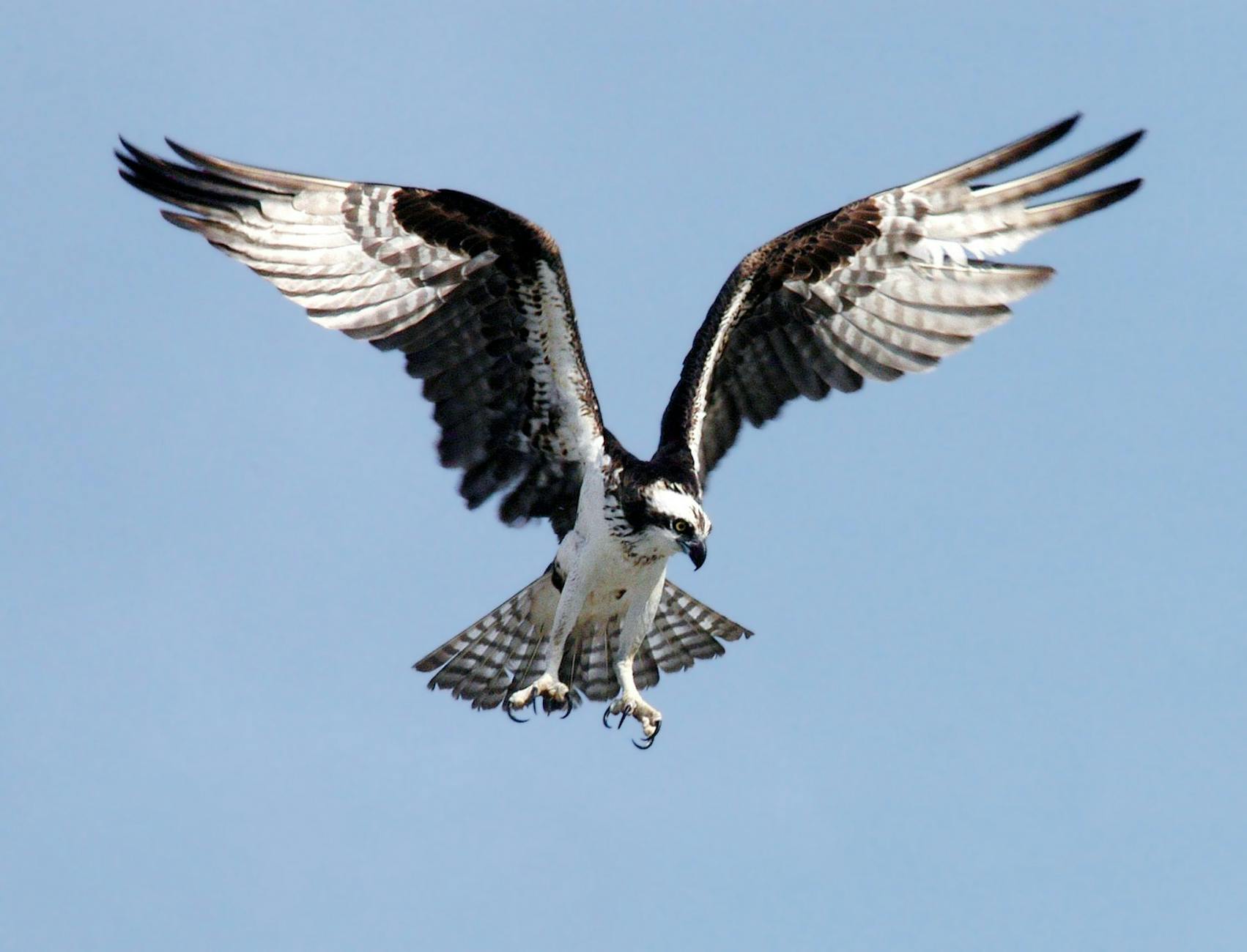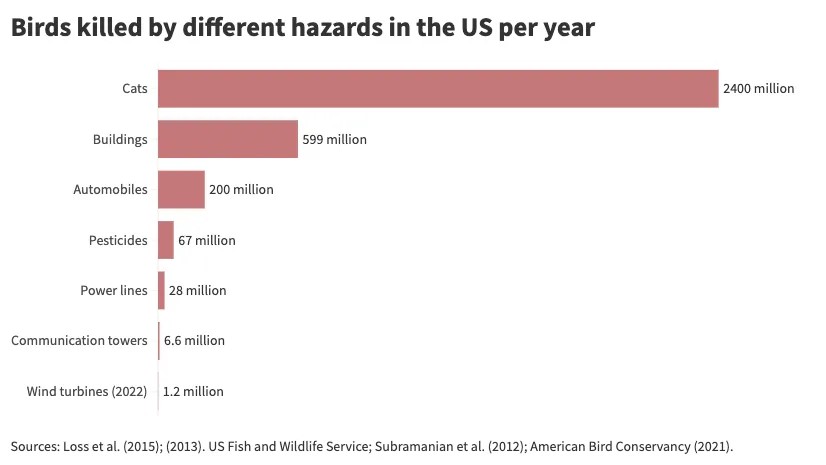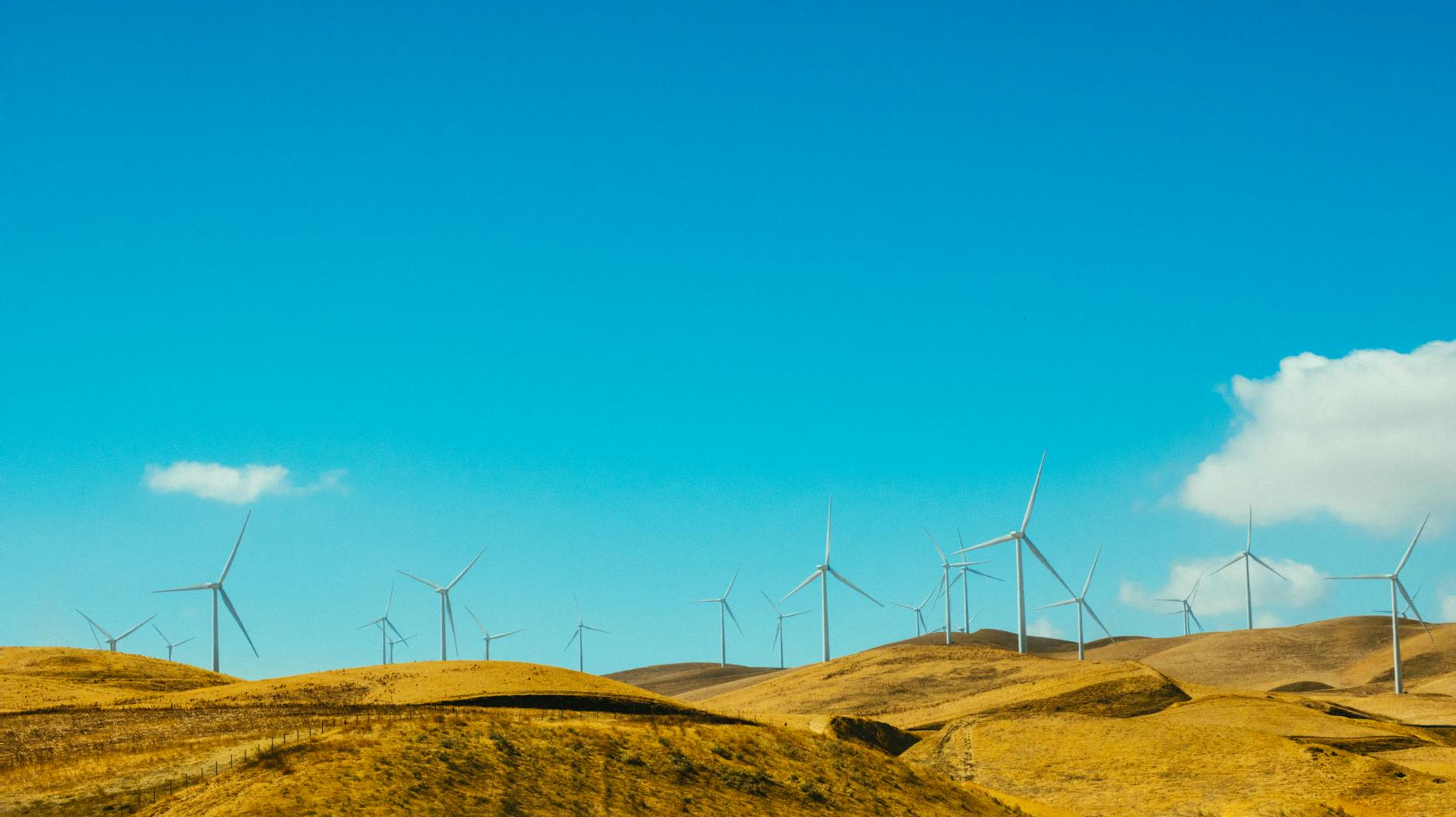Superfact 17: Fossil fuels kill a lot more birds per gigawatt hour than wind power does. Cats, windows, cars, poison and powerlines are examples of things that kill a lot more birds than wind power does. Wind power killing birds is not the huge environmental problem it is often made out to be.
Wind power killing birds is often mentioned as a slam dunk environmentally based argument against wind power and evidence for the hypocrisy of environmentalists. This is misguided. Wind power killing birds is a real problem and it should be addressed, and it is being addressed. No energy source comes without environmental problems. However, wind turbines account for only a small fraction of overall bird deaths compared to other human causes. It is not a good argument against wind power, and it does not demonstrate any hypocrisy by environmentalists. In fact, a study made in 2012 (overview here) concluded that fossil fuels killed 24 million birds per year in the US, which correspond to 35 times more birds per GWh than wind power kills according to this study. Even though this study and other similar studies are estimates based on assumptions that are far from perfect, they are good indicators that replacing fossil fuels with wind power likely saves birds rather than kills them.

In any case, as this Wikipedia article states, collisions with wind turbines are a minor source of bird mortality compared to other human causes. According to the graph below cats kill 5,600 times more birds than wind power and collisions with powerlines kills 99 times more birds than wind power, and yet we rarely discuss these problems. Even though these numbers are estimates they are mostly confirmed by other studies and analysis, as this overview from MIT and this analysis by Hannah Richie shows. The numbers aren’t the same, but they make the same point. FYI Hannah Richie is the deputy editor and lead researcher at Our World in Data. Our World in Data is a scientific online publication that focuses on large global problems. They are associated with Oxford University and is one of the most respected statistics, analysis and research organizations in the world.


Wind power has been on the receiving end of false claims, nonsense, and strange rumors for quite some time. It is not the only energy source maligned by false information, but it is an interesting case study in misinformation regarding energy sources. To read about nonsense and rumors about wind power click here.



I never cease to be surprised at some of the lies circulating around wind power generation. But…there is a ton of money to be made by extracting fossil fuels, so a lot of wealthy folks have a vested interest in misinforming the public about renewable energy sources.
LikeLiked by 1 person
Yes you are right. There is so much misinformation and propaganda and people typically believe whatever fits their agendas and preconceived notions rather than evidence and expertise. Hopefully superfactful can help a little bit with that. Thank you for your comment Alex.
LikeLiked by 1 person
Read an article about what the Danes are doing to prevent bird deaths in their turbines. They’re using radar to search for masses the same as birds within a certain distance from a turbine. If a bird is seen to be going in a dangerous path, they turn off the nearest turbine. It can be done more quickly than you think. In one year they have closed down turbines 15,000 times and that was during a period when the turbines were already stopped due to icy conditions. I can’t remember the number of bird deaths mentioned but it was dramatically lower than before. So, there are ways to mitigate the danger.
LikeLiked by 1 person
That is great news. I should maybe have added something about how bird deaths can be mitigated. I know there are ways to get birds to avoid wind turbine blades, colors, shapes, sounds/sonar, etc. I did not know the Danes were doing what you describe but I am not surprised they have invested in this. Significantly more than half of their power comes from wind power.
LikeLike
Very interesting, Thomas! Thanks for bringing further insight on the wind power subject. On the whole, it seems much less harmful than the most used power sources. May be the only concern regarding the wind turbines is still their visual impact on the landscape. Lots of light and blessings to you, my friend*
LikeLiked by 1 person
Thank you so much Susana. No energy source is without problems, but there is a lot of misinformation about the various energy sources, especially wind. This misinformation needs to be contradicted. Lots of light and blessings to you too, my friend.
LikeLiked by 1 person
😱 I have two cats but they’ve been trained not to kill birds
LikeLiked by 1 person
That is good. I should say this post was not anti-cat no matter how much dogs would like to see it that way. But just to put things in perspective. It is their instinct and that’s the way nature is. Our dog Rollo killed two rabbits. I don’t have any dog-rabbit statistics but there are 900 million dogs in the wolrd.
LikeLike
Hi Thomas, I know it was facts, but the facts are rather horrifying.
LikeLiked by 1 person
Yes I guess you are right. In fact, I read somewhere that cats may be killing so many birds that it is a real problem. There are more cats in the US (42+ millions) than nature would have supported without human caretakers.
LikeLike
Of course, the same applies to dogs and all other domesticated animals. We chose what we wanted to breed for our own purposes.
LikeLiked by 1 person
Yes you are right of course. There are even more dogs than cats. We changed nature. Wildlife is threatened but domesticated animals are thriving, or at least they exist in large numbers. Cows may not have happy lives but there’s 1.5 billion of them in the world and there wouldn’t be that many without us.
LikeLike
Oona: “See? Wind power is not the biggest threat to birds. OONA IS!”
Lulu: “You literally never go outside.”
Oona: “JUST LOOK AT THE CHART!”
LikeLiked by 1 person
Ha ha dogs can have a blast with that statistics.
LikeLike
Thanks for the good post. I’d seen some of these statistics before, but I’m glad to see you combatting some of the misinformation about wind power.
LikeLiked by 1 person
Thank you so much David. I appreciate your kind comment.
LikeLiked by 1 person
Very interesting, Thomas. I had no idea that power lines are so dangerous. I would have said airplanes.
Our kitchen door keeps on getting in the way of flying pigeons 🙂 No casualties yet.
LikeLiked by 1 person
Thank you so much Patricia. Yes airplanes wasn’t included in the studies above but I knew about cars and windows. I’ve had a few birds crash into car windshields and windows on our house. Cats of course. I see cats carrying around dead birds and rabbits all the time.
LikeLike
This is why my formerly feral cat is strictly an indoor cat since I rescued her 4 years ago. Still, I think they should paint the tips of the turbines and do whatever they can to make them more visible to birds.
LikeLiked by 1 person
Yes I agree. Any steps taken to reduce bird deaths should be taken. I should say I did not intend to complain about cats, it was just for comparison, and I think we people kill more birds/chickens for chicken nuggets anyway. But it is great that your cat is an indoor cat now.
LikeLiked by 1 person
True about chicken nuggets. And most chickens don’t live happy lives.
LikeLiked by 1 person
Yes unfortunately factory farming is a cruel business.
LikeLike
You’d think that with such sharp vision, birds would be able to see the blade of the turbine and avoid it.
LikeLiked by 1 person
Yes you are right World Questioner, but sometimes they don’t. However, the important thing to remember is birds colliding with blades of turbines is not as a big problem as it is made out to be. Bird deaths from other causes are much bigger (fossil fuels, cats, windows etc.) There are also ways to mitigate the problem.
LikeLike
I posted a comment on https://www.youtube.com/watch?v=lL6uB1z95gA (“Renewable energy is the scam we all fell for” by Thoughty2) linking to this post of yours. You can watch the video yourself. Some of its claims have already been addressed by you?
LikeLiked by 1 person
Thank you World Questioner, I might have time to watch it later.
LikeLike